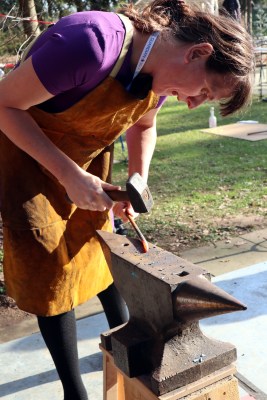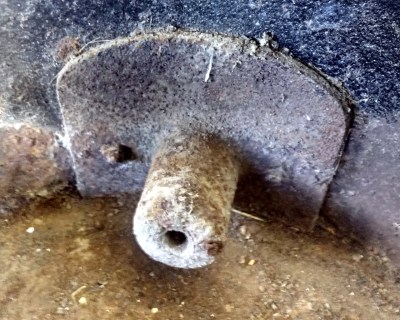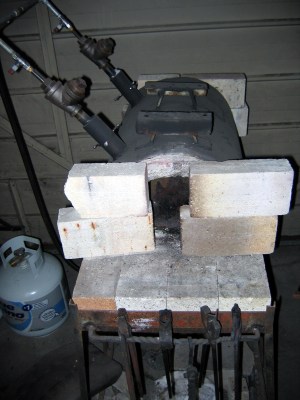Blacksmithing For The Uninitiated: What Is A Forge?
Forge #Forge

Blacksmiths were the high technologists of fabrication up until the industrial revolution gained momentum. At its core, this is the art and science of making any needed tool or mechanism out of metal. Are you using the correct metal? Is the tool strong where it needs to be? And how can you finish a project quickly, efficiently, and beautifully? These are lessons Blacksmiths feel in their bones and it’s well worth exploring the field yourself to appreciate the knowledge base that exists at any well-used forge.
I had an unexpected experience a few days ago at the Hacker Hotel weekend hacker camp in the Netherlands. At the side of the hotel our friends at RevSpace in The Hague had set up a portable forge. There was the evocative coal fire smell of burning coke from the hearth, an anvil, and the sound of hammering. This is intensely familiar to me, because I grew up around it. He may be retired now, but my dad is a blacksmith whose work lay mostly in high-end architectural ironwork.
 Working the RevSpace forge at Hacker Hotel, in not the most appropriate clothing for the job.
Working the RevSpace forge at Hacker Hotel, in not the most appropriate clothing for the job.
The trouble is, despite all that upbringing, I don’t consider myself to be a blacksmith. Sure, I am very familiar with forge work and can bash metal with the best of them, but I know blacksmiths. I can’t do everything my dad could, and there are people we’d encounter who are artists with metal. They can bend and shape it to their will in the way I can mould words or casually solder a tiny surface-mount component, and produce beautiful things in doing so. My enthusiastic metal-bashing may bear the mark of some experience at the anvil but I am not one of them.
It was a bit of a surprise then to see the RevSpace forge, and I found myself borrowing a blacksmith’s apron to protect my smart officewear and grabbing a bit of rebar. I set to and made a pretty simple standard of the dilletante blacksmith, a poker with a ring on one end. Hammer one end of the rebar down to a point, square off the other end for just over 3 times the diameter of the ring, then bend a right angle and form the ring on the pointy end of the anvil. Ten minutes or so of fun in the Dutch sunshine. Working a forge unexpectedly brought with it a bit of a revelation. I may not be a smith of a high standard, but I have a set of skills by virtue of my upbringing that I had to some extent ignored.
Where others might have put effort into learning them, they’re things I just know. It had perhaps never occurred to me that maybe all my friends in this community didn’t learn how to do this by hanging round the forge next to the house they grew up in. If I have this knowledge merely by virtue of my upbringing, perhaps I should share some of it in a series of articles for those in our community who’ve always fancied a go at a forge but have no idea where to start.
What Is A Forge? ![A well-equipped forge, that of Finnish blacksmith Jesse Sipola. Wasapl [CC BY-SA 3.0].](https://hackaday.com/wp-content/uploads/2019/02/1280px-0_typical_smithy_in_finland.jpg?w=800) A well-equipped forge, that of Finnish blacksmith Jesse Sipola. Wasapl [CC BY-SA 3.0]. So perhaps you’re expecting me to dive straight in and take you to the forge work, but no. Starting with the very basics, what is a forge? Perhaps this is merely the lexical pedantry of a former dictionary employee, but this is a word that is so often misused. You will see people describe themselves as having made a forge when they have in fact only made a hearth, the means of heating metal. A forge is in fact the whole shop, if a metalworking shop contains a blacksmith, it is a forge. So we’re going to take that whole-shop approach, and start by going through the equipment you might find in a typical forge. Perhaps we’ll skip the power hammers of a larger operation and It’ll have a British flavour to it because that’s where my experience lies, but if you read this I hope you’ll have a better idea what you might need for this kind of work in your workshop or hackerspace.
A well-equipped forge, that of Finnish blacksmith Jesse Sipola. Wasapl [CC BY-SA 3.0]. So perhaps you’re expecting me to dive straight in and take you to the forge work, but no. Starting with the very basics, what is a forge? Perhaps this is merely the lexical pedantry of a former dictionary employee, but this is a word that is so often misused. You will see people describe themselves as having made a forge when they have in fact only made a hearth, the means of heating metal. A forge is in fact the whole shop, if a metalworking shop contains a blacksmith, it is a forge. So we’re going to take that whole-shop approach, and start by going through the equipment you might find in a typical forge. Perhaps we’ll skip the power hammers of a larger operation and It’ll have a British flavour to it because that’s where my experience lies, but if you read this I hope you’ll have a better idea what you might need for this kind of work in your workshop or hackerspace.
Blacksmithing starts with heating a piece of metal to a temperature at which it becomes readily malleable, so every forge must have some form of hearth or furnace in which that can be done. There is a choice in this matter, between solid fuel, gas, and even electric induction. We’d love to see our community prove us wrong on this but the last option may be beyond the mains hook-up of most experimenters, so assuming that you have somewhere with enough ventilation or flue to safely run one we’ll look at the solid fuel and gas hearths that might be within the reach of an experimenter.
Gas Or Solid Fuel, Which Is For You?  A cast-iron tuyere, part of a small portable hearth. This would normally be surrounded by firebrick.
A cast-iron tuyere, part of a small portable hearth. This would normally be surrounded by firebrick.
If you think of a traditional blacksmith’s forge, you may be imagining a broad square or rectangular hearth with a chimney hood over it, upon which sits the bright glow of a coke fire. (If you are unfamiliar with it, coke is simply coal which has had the volatile components removed by heating, leaving mostly just the carbon. This is the fuel upon which blast furnaces run.)
In older buildings they may be built into the fabric of a wall, but more modern ones will be more like a steel table. They will have a recess lined with firebrick in which the fire sits, at one side of which will be a cast-iron nozzle called a tuyere (Originally a French word, pronounced something like “tweer” in English) through which air is blown to sustain the fire.
Rustic traditional forges might have had a set of bellows for the air supply, but modern ones will have a centrifugal fan or similar. It’s important to note that the requirement is not for a blast of high-pressure air but for a constant draught, as if you were able to blow continuously upon it. For this reason fan motors will often have some means of speed control.
 A gas hearth, showing fire bricks. This one appears to use two gas torches. tmib_seattle (CC BY-SA 2.0)
A gas hearth, showing fire bricks. This one appears to use two gas torches. tmib_seattle (CC BY-SA 2.0)
The good news is that you can make your own solid fuel hearth with ease. If you don’t fancy fabricating a large sheet metal construction in the manner of the commercial forges there are plenty of other things that can be pressed into use. The classic quick-and-dirty portable hearth is a truck brake drum lined with firbrick, but a quick internet search will find converted barbecues, automotive wheels, and even pet food bowls. The tuyere will need some attention though, unless you treat it as a sacrificial item that just burns away it will need to be substantial enough not to get too hot. Commercial tuyeres are surprisingly expensive, but there should be many pieces of cast iron that could be adapted. For years my dad’s hearth used the central boss from a very large cast iron industrial pulley, for example.
Gas hearths are similarly easy to construct, in that a decent sized propane blowtorch will provide enough power when its flame is contained within a firebrick structure to contain that heat. At its simplest this can be a loosely assembled set of firebricks as my dad used when he needed to go on-site, but it can easily be a more robustly assembled furnace. A well-known DIY project is the so-called coffee can hearth, in which a metal can is lined with fireclay. A word of warning with respect to gas hearths comes with respect to the safety of handling bottled gas. Some of the smaller handheld gas torches might not quite have enough heat in them to do much good.
How Hot Should You Go? ![A good illustration of working temperature in terms of colour, the end of the piece is yellow rather than white-hot. fir0002 [GFDL 1.2]](https://hackaday.com/wp-content/uploads/2019/02/1280px-removing_rust_with_sand.jpg?w=400) A good illustration of working temperature in terms of colour, the end of the piece is yellow rather than white-hot. fir0002 [GFDL 1.2] Once you have your hearth, it’s very tempting to start heating up a bit of metal and have a go with it. But before doing that it’s worth considering what the aim in heating the metal is and how hot it should be. When heating a piece of iron and steel the best way to judge its readiness for working is by its colour, so it’s best to think of this in terms of malleability rather than temperature.
A good illustration of working temperature in terms of colour, the end of the piece is yellow rather than white-hot. fir0002 [GFDL 1.2] Once you have your hearth, it’s very tempting to start heating up a bit of metal and have a go with it. But before doing that it’s worth considering what the aim in heating the metal is and how hot it should be. When heating a piece of iron and steel the best way to judge its readiness for working is by its colour, so it’s best to think of this in terms of malleability rather than temperature.
If you crank up the air on a solid fuel hearth it can become very hot indeed, to the extent that a piece of steel will happily melt or even burn in it when left too long. You will either be left with a puddle of iron in the bottom of the hearth, or withdraw a piece of white-hot steel that is burning and sending off sparks like a firework. Both of these are things a much younger me has managed, you only learn some things as a teenager by experience.
Your aim should be to run the forge with just enough air or gas to take the metal to working temperature, at which point it should be at most a not-too-pale yellow in colour and certainly not shedding any sparks. It’s a finely judged process, but I will push the piece of metal into the coals to about 1″ (2.5cm) beneath the surface such that I can still just see it, and withdraw it at the point that its colour just about matches that of the burning coals. I then have somewhere up to a minute’s working time with a piece of light steel, during which time it progresses from yellow through orange to a dull red.
Our path through starting forge work will be quite a long one, because to do it justice will require a lot of topics to be covered. Having talked in general about the origins of this series and then about hearths, we’ll move on in the next part of this series to the anvil. It’s the most iconic of blacksmith’s tooling, and holds a surprising complexity. See you next time!